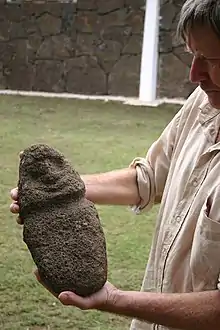Mike Seager Thomas
Mike Seager Thomas is a British archaeologist, author and Honorary Research Fellow of the UCL Institute of Archaeology specialising in the study of stone in prehistoric archaeology and landscape archaeology.[1][2]
Career

Mike Seager Thomas first studied archaeology at Brighton Technical College, later gaining a first class honours degree in General Archaeology from the UCL Institute of Archaeology.[2] He has been a full time professional archaeologist since 1996. Between 1996 and 2020, he worked in the commercial sector as an excavator/excavation supervisor (for Archaeology South-East, BUFAU and C.G. Archaeology) and as a freelance prehistoric pottery specialist.[3] Mike Seager Thomas is also a long-term participant in UCL Institute of Archaeology research projects, including the well-known Leskernick Project,[4] the Tavoliere-Gargano Prehistory Project,[5] and—most recently—the Rapa Nui (Easter Island) Landscapes of Construction Project.[2][6][7] Out of his involvement in the Leskernick Project, he became the principal butt of project sociologist Mike Willmore's very funny "The Book and the Trowel,"[8] published in the Leskernick project book Stone Worlds,[9] and the perceived victim of a "top-down interpersonal project hierarchy," which challenged the egalitarian pretensions of what is otherwise considered a theoretically seminal archaeological project.[10][11][12] He has directed and co-directed archaeological excavations for the Sussex Wildlife Trust[13] and the Sussex Archaeological Society[14][15] and set up and directed independent projects, involving the rescue excavation of prehistoric features exposed in the Selsey Raised Beach, West Sussex,[16] and the analysis of later prehistoric stone finds from southeast England.[17] He has ongoing academic interests in stone in prehistoric archaeology and landscape archaeology, recording strategies for Rapa Nui archaeology, Polynesian architecture, the faking of military antiques, and the use of period photographs in archaeological and historical research.[18] Books by Mike Seager Thomas include Excavating Stone Worlds, co-written with Sue Hamilton and Phillip Thomas and published in 2007,[19] the Afrikamütze Database,[20][21][22] published online in 2019, and Neolithic Spaces, Volume 2: The Bradford Archive of Aerial Photographs, published in 2020.[5]
References
- "Mike Seager Thomas". Retrieved 21 March 2021.
- UCL (2019-01-22). "Michael Seager Thomas - Honorary Research Associate". Institute of Archaeology. Retrieved 2021-03-21.
- "Artefact Services: archaeological stone and British prehistoric pottery analysis". Artefact Services: archaeological stone and British prehistoric pottery analysis. Retrieved 2021-03-21.
- "Leskernick Homepage". www.ucl.ac.uk. Retrieved 2021-03-28.
- "Research". Mysite. Retrieved 2021-03-28.
- Hamilton, Sue (2013). "Rapa Nui (Easter Island)'s Stone Worlds" (PDF). Archaeology International. 16: 108.
- UCL (2019-01-22). "Rapa Nui Landscapes of Construction". Institute of Archaeology. Retrieved 2021-03-28.
- Willmore, Mike (2007). The Book and the Trowel. In Stone Worlds: Narrative and Reflexivity in Landscape Archaeology. Walnut Creek, CA: Left Coast Press. pp. 244–76.
- Bender, Barbara; Hamilton, Sue; Tilley, Christopher (2007). Stone Worlds. Walnut Creek, CA: Left Coast Press. pp. 244–76.
- Krsmanovic, Damjan; Anderson, William. "Critiquing the archaeological diary". P.i.t.: Archeologische ervaringen 6, 29-40.
- "How Can Phenomenological Methodologies help us understand past Landscapes? | The Post Hole". www.theposthole.org. Retrieved 2021-03-28.
- "Review of Stone Worlds: narrative and reflexivity in landscape archaeology | Studio Michael Shanks ~ Stanford". Retrieved 2021-03-21.
- Greatorex, Christopher; Seager Thomas, Mike (2000). "Rock Shelter Stratigraphy". Sussex Archaeological Collections. 138: 49–56. doi:10.5284/1085746 – via Archaeology Data Service.
- "Sussex Archaeological Collections: Relating to the history and antiquities of the counties of East and West Sussex". Archaeology Data Service. Retrieved 2021-03-21.
- Seager Thomas, Mike (2005). "Understanding Iron Age Norton". Sussex Archaeological Collections. 143: 83–115. doi:10.5284/1085968.
- "Two early first millennium BC wells from Selsey, West Sussex and their wider significance". Antiquaries Journal. 81: 15–50. 2001. doi:10.1017/S0003581500072139. S2CID 129145465 – via Internet Archive.
- "Written in Stones". Sussex Past. Sussex Arch Soc Newsletter. 86: 7. 1998.
- ORCID. "Mike Seager Thomas (0000-0002-4767-346X)". orcid.org. Retrieved 2021-05-02.
- Excavating Stone Worlds. London: UCL Press. 2007. ISBN 978-1844721375.
- The Afrikamütze Database. A guide to the identification, context and interpretation of the German army tropical field cap, 1940–43. Part 1: The Authentic Cap. Artefact Services Research Papers 8/1. Lewes: Artefact Services. 2019.
- The Afrikamütze Database; A Guide to the Identification, Context and Interpretation of the German Army Tropical Peaked Cap, 1940–43, Part 2: The Fake. Artefact Services Research Papers 8/2. Lewes: Artefact Services. 2019.
- The Afrikamütze Database. A guide to the identification, context and interpretation of the German army tropical peaked cap, 1940–43. Part 3: References & Appendices. Artefact Services Research Papers 8/3. Lewes: Artefact Services. 2019.